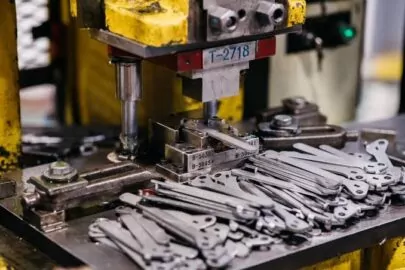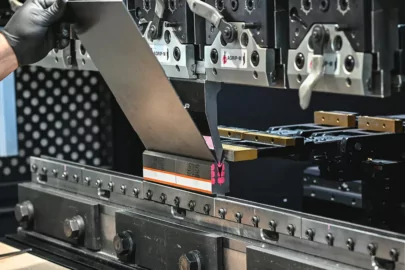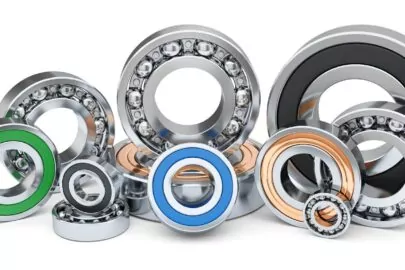Welding joints are fundamental to the welding process, serving as the points where two or more metal components are fused. Selecting the right welding joint is essential for achieving structural integrity and functionality in a project.
Whether you’re working on a large-scale industrial application or a smaller precision-based project, understanding the different types of welding joints helps ensure optimal strength, durability, and efficiency.
In this guide, we’ll explore the five basic types of welding joints—Butt, Corner, Lap, T, and Edge—along with their unique features and applications.
5 Basic Types of Welding Joints

When selecting the right welding joint for a project, several crucial factors must be carefully evaluated. Welding joints vary in their suitability depending on the material being used, the strength requirements, the accessibility of the joint, and the desired appearance of the weld. Below is a detailed breakdown of the features and applications of the five primary types of welding joints.
Butt Joint
A butt joint is one of the most common and straightforward types of welding joints. It involves two metal plates placed edge to edge in the same plane and welded along the seam. This joint type is widely used across industries for joining flat plates or pipes.
Features:
- Two metal plates are positioned end-to-end in the same plane.
- Requires minimal preparation and filler material.
- Simple to execute and provides a smooth finish.
- Cost-effective and efficient for large-scale projects.
- Requires precise alignment and heat control to avoid distortion.
Applications:
- Frequently used in piping systems.
- Applied in structural frames for buildings and bridges.
- Common in the automotive industry for chassis and frame construction.
- Shipbuilding and plumbing often employ butt joints for joining large, flat plates.
- Often utilized for boilers, pressure vessels, and other areas where sealing is essential.
Corner Joint
A corner joint is formed when two metal plates meet at a 90-degree angle, creating an “L” shape. This joint is essential for assembling box-like or frame structures.
Features:
- Creates a 90-degree angle between two metal plates.
- Can be either open or closed, depending on the required strength and application.
- Requires more filler material than a butt joint.
- Offers excellent strength in applications that involve angular stresses.
- Ideal for structures subject to right-angle forces.
Applications:
- Widely used in the construction of metal frames, boxes, and containers.
- Popular in furniture fabrication and metal enclosures.
- Essential in building frames for machinery and HVAC systems.
- Often used in fabricating steel frames in building structures.
- Useful in assembling enclosures and tanks for liquid storage.
Lap Joint
A lap joint is created when two metal plates overlap one another. This type of joint is suitable for situations where the materials have different thicknesses or when extra strength is needed.
Features:
- Two plates overlap, increasing the contact surface area for the weld.
- Provides enhanced strength compared to butt or edge joints.
- Well-suited for joining dissimilar material thicknesses.
- Efficient for welding thin and thick materials together.
- Requires less preparation but results in visible overlap.
Applications:
- Frequently used in automotive and aerospace industries for joining different thicknesses of metal.
- Common in sheet metal work for structural support.
- Applied in metal fabrication where additional strength is needed along the overlap.
- Useful for reinforcing joints in industrial machinery and equipment.
- Often applied in electrical and electronic enclosures, where structural integrity is critical.
T-Joint
A T-joint is formed when one metal plate is placed perpendicular to another, forming a “T” shape. This joint provides excellent strength and is often used in load-bearing applications.
Features:
- One plate is positioned perpendicular to another, forming a T-shape.
- Fillet welds are typically applied on both sides of the intersection.
- Requires more filler material but provides high strength and durability.
- Suitable for projects requiring load-bearing welds.
- Offers excellent resistance to stress in both vertical and horizontal directions.
Applications:
- Common in the construction of structural steel frameworks.
- Used in shipbuilding to connect beams and support columns.
- Applied in the manufacturing of heavy machinery components.
- Popular in trusses and frameworks that require high-strength welding.
- Ideal for the construction of bridge supports and towers requiring added load distribution.
Edge Joint
Edge joints are used when two metal pieces are placed side by side and welded along their edges. While not as strong as other joints, they are useful for sealing thin materials and are often employed in non-load-bearing applications.
Features:
- Two plates are placed side by side, with welds applied along their edges.
- Suitable for thin materials where load-bearing is not a concern.
- Offers a minimal footprint for the weld, making it ideal for certain sheet metal work.
- Less filler material is required compared to T- and corner joints.
- Not recommended for high-stress or load-bearing applications.
Applications:
- Used in sheet metal fabrication for products like metal enclosures or containers.
- Common in the shipbuilding industry for sealing edges of metal plates.
- Employed in automotive manufacturing to create durable yet lightweight structures.
- Suitable for welding thin materials in applications where minimal weight and space are required.
- Frequently used for creating metal storage tanks, where the sealed edges help prevent leaks.
These five basic welding joints—Butt, Corner, Lap, T, and Edge—each have their own strengths, limitations, and applications, making it essential to select the appropriate joint for your specific project needs. Understanding the features and practical uses of each type will help ensure that your welded structures are strong, durable, and suited to their intended purpose.
How to Choose the Right Welding Joint?

When selecting the right welding joint for a project, several crucial factors must be carefully evaluated. Each type of welding joint offers different benefits and drawbacks depending on the specific requirements of your project.
By considering elements such as cost, material thickness, strength requirements, accessibility, and aesthetics, you can ensure that the welding joint you choose will optimise both the process and the performance of the final product. In this expanded section, we’ll delve deeper into the key considerations you need to assess to make an informed decision when choosing the most appropriate welding joint.
Cost
Cost is one of the most significant factors when selecting the right welding joint, as it directly impacts the overall budget of a project. Different types of joints require varying levels of preparation, filler material, and labour, which all contribute to the total cost.
For instance, butt joints are typically more economical because they require minimal preparation and filler material, especially when working with metals of similar thickness. The process is straightforward, and it often involves a single weld pass, which reduces time and labour costs. On the other hand, lap joints are similarly cost-effective because they involve overlapping materials, which means less filler material is required to complete the joint.
In contrast, corner joints and T-joints can be more expensive due to the additional time and materials needed to ensure a strong, reliable weld. These joints often require fillet welds, which involve depositing a significant amount of filler material along the junctions, thus increasing costs. Additionally, edge joints, though not commonly used for load-bearing purposes, may also incur extra costs in applications where sealing the edge or reinforcing thin metals is required.
Understanding how each type of joint impacts the project cost allows you to strike a balance between efficiency and budget constraints. For cost-conscious projects, opting for simpler joints like butt or lap joints can be a more budget-friendly option without sacrificing weld integrity.
Material Thickness
The thickness of the materials to be welded is another critical factor in selecting the right welding joint. Each type of joint responds differently depending on whether you are working with thin or thick materials, and choosing an appropriate joint is essential to ensure structural stability and strength.
For thin materials, lap joints and edge joints are often the best choices. Lap joints, for instance, offer an increased surface area for the weld, allowing for a stronger bond between the overlapping plates. Edge joints, though not typically used in load-bearing applications, are useful for thin plates that only need to be sealed along their edges. These joints are practical when working with sheet metal, as they allow for easy and effective welding without excessive heat input that could warp or damage the thin materials.
In contrast, thicker materials are better suited for butt joints, T-joints, and corner joints, which provide the necessary strength to support heavy loads or withstand high stress. Butt joints are particularly effective when the thickness of the materials is the same, allowing for a smooth, seamless connection. For larger, heavier structures, T-joints and corner joints offer increased strength and durability, as they typically involve fillet welds that add extra reinforcement to the joint.
Strength Requirements

Strength is a primary consideration when choosing a welding joint, especially for applications where the welded structure will be subjected to heavy loads, high stress, or adverse conditions. Different welding joints offer varying levels of strength, and selecting the appropriate joint ensures the final product can withstand the intended forces.
For projects that require maximum strength, T-joints, lap joints, and corner joints are ideal options. These joints are commonly used in heavy industries such as construction, shipbuilding, and automotive manufacturing, where structural integrity is critical. For instance, T-joints provide excellent strength due to the perpendicular alignment of the two welded pieces, making them well-suited for applications that bear vertical loads. Corner joints are similarly strong and are often used in constructing frames, boxes, and machinery.
If the strength requirements are less critical, butt joints and edge joints may be sufficient. Butt joints can provide reliable strength in applications where the materials are of similar thickness, and the load-bearing requirements are moderate. However, edge joints are generally not recommended for high-stress applications, as they are not designed to handle heavy loads. Edge joints are typically reserved for thinner materials where the primary goal is to seal the edges rather than support significant weight.
Accessibility and Positioning
The accessibility and positioning of the joint play a key role in determining the appropriate welding joint for a project. Some joints are easier to access and weld, especially in tight spaces or awkward positions, while others require more precision and preparation to ensure a strong bond.
For projects where the welding area is easily accessible, butt joints and lap joints are often the preferred choice. These joints involve relatively simple welds that can be completed quickly without requiring extensive manipulation of the materials. In contrast, corner joints and T-joints may be more difficult to access depending on the structure’s geometry. These joints often require careful positioning and multiple passes to ensure full penetration and a reliable weld.
Edge joints are sometimes the most convenient choice in applications where the edges of two plates must be welded together without much room for manoeuvre. This is especially true in sheet metal fabrication, where access to the edges is generally straightforward.
In some cases, the accessibility and positioning of the weld may influence the decision to use certain welding processes over others. For instance, laser welding or TIG welding may be more appropriate for joints that require precision in hard-to-reach areas, while MIG welding or stick welding may be better suited for joints that are easily accessible and allow for higher deposition rates.
Conclusion
Choosing the right welding joint is crucial for achieving both functionality and structural integrity in any project. Whether it’s a butt joint for simplicity or a T-joint for maximum strength, understanding the different types of joints allows for more informed decisions.
For companies seeking high-quality welding solutions, Zintilon offers comprehensive services for a wide range of projects. With their advanced technology and expert team, Zintilon ensures precision and quality in every weld. Whether you’re working on complex structural applications or precision manufacturing, Zintilon can meet your needs. Contact Zintilon today to elevate your project with expert welding services.
Great, Together



